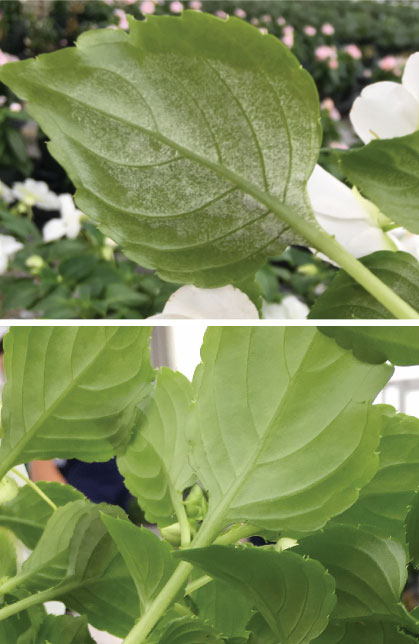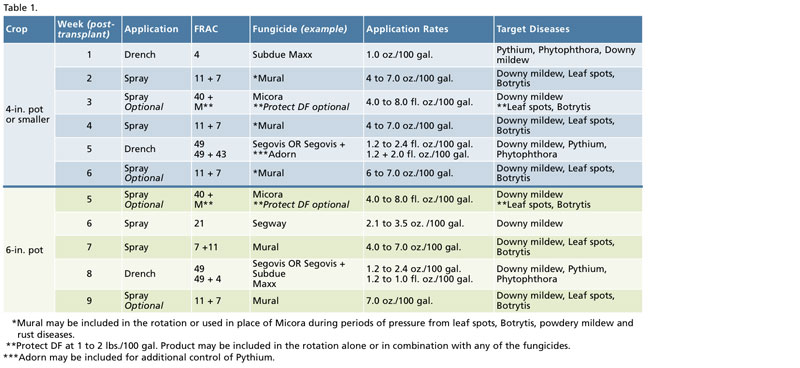2/1/2021
No Patience for Impatiens Downy Mildew in 2021
Nancy Rechcigl

Were you troubled by impatiens downy mildew last year? Impatiens downy mildew (IDM) is one of the most notorious diseases to affect ornamental greenhouse productions. In 2011, IDM decimated the impatiens market and became unmanageable in almost every country, including the U.S. However, with recent fungicide innovations, new genetics and the use of robust rotation programs to fight resistance, healthy impatiens can be produced that perform successfully in the landscape.
Pictured top: Untreated impatiens with downy mildew.
Pictured bottom: Impatiens treated with Segovis 1.2 fl. oz. drench.
The disease
Downy mildew, caused by the pathogen Plasmopara obducens, can be mistaken for other issues, including foliar spray injury, nutritional imbalance, chilling or even spider mite infestations. The time it takes for crops to begin showing symptoms after infection occurs varies anywhere from five to 14 days. Symptoms can be delayed or masked by high fertility levels, so it’s imperative to monitor crops closely, especially when they’re young seedlings. The most common symptoms of IDM include:
• Leaf discoloration or spotting, often within the veins
• Pale foliage with yellow, tan or red blotchy areas
• Distorted, wilting or downward curling of the leaves
• White, light gray or purple fuzz on the undersides of leaves
• Small emerging leaves
• Flower buds fail to form
• Stunting of plant growth/malformation of leaves and flower buds
This pathogen prefers cool, moist conditions with temperatures between 59 to 75F (15 to 23C) being optimum for sporangia formation and zoospore germination. It’s important to remember only a thin layer of moisture on leaves is needed for disease development in these conditions.
In dry and warm conditions, sporulation may not occur, or is reduced, and symptoms may be less severe. This can also occasionally lead to inadvertent movement of infected plants, allowing the pathogen to spread.
Cultural management
When preparing for impatiens production, keep these cultural tips in mind to avoid the development of IDM:
• Keep growing environment clean and dry
• Scout frequently for disease symptoms
• Irrigate early in the day
• Keep humidity low and space plants out to allow for good air flow
• Remove diseased plants immediately to limit spore production and spread
Innovations in breeding
Extensive efforts have been made in developing new lines of impatiens with resistance to Plasmopara obducens, such as Imara XDR. While disease pressure within production may appear to be low and manageable with resistant varieties alone, they’re not totally immune. The real success is measured if the plants can maintain their landscape performance under disease pressure, year after year. Resistant varieties provide another tool to manage or avoid IDM and achieve a successful outcome. When they’re used in a program with effective fungicide products, there’s the greatest chance of success.
Resistance management is just as important with plant genetics that are bred for tolerance to a disease as it is for preserving new chemistry. Over time, new strains of the pathogen will evolve that overcome the plants’ tolerance or resistance traits. A fungicide program can help preserve genetic resistance, and depending upon the product and timing, help ensure optimum landscape performance.
Fungicide rotations
When it comes to fungicide treatments, there are many innovative tools available to help you successfully produce impatiens. Implementing a rotation program featuring products with different modes of action is critical for resistance management so the effectiveness of plant protection chemistries can be preserved.
Following a program that utilizes a “systemic sandwich” approach is recommended for growing impatiens. Systemic fungicides are applied as a drench at transplant or at the beginning of production and prior to shipping, while the other fungicides with contact or translaminar activity may be applied as sprays in between for resistance management and to assist in controlling other disease problems as needed. The use of an effective systemic fungicide as a drench a week or two prior to shipping provides extended protection in the landscape for the consumer, which is critical for garden performance.
Segovis fungicide has a unique mode of action and can be applied as a drench for long-lasting control of IDM. This product is ideal for rotation programs, as its active ingredient in FRAC Group 49 can help diversify treatments. Segovis is positioned as the final treatment prior to shipping, as it offers extended residual activity.

Table 1 shows a program that was developed by Syngenta for use in greenhouse operations for controlling downy mildew in bedding plants such as impatiens, as well as other herbaceous crops. It’s meant to provide a framework for positioning treatments, utilizing the products’ strengths and modes of action at times when they’ll provide the maximum benefit.
Having a plan when growing impatiens for spring sales is crucial for a successful crop. New innovations in plant protection products and genetics provide the tools you need to successfully produce impatiens in the greenhouse with season-long performance in the garden. GT
Nancy Rechcigl is a technical services manager for ornamentals for Syngenta.